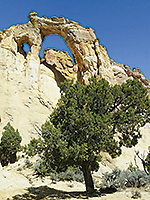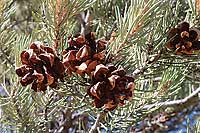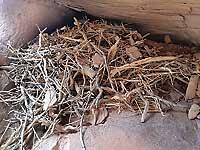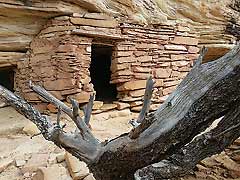 Millions of acres across the Southwest are covered with pinyon-juniper woodlands, locally known as the “PJ.” The term “woodlands” might be a bit of an exaggeration compared to what most folks imagine a forest to resemble. In the PJ, the trees may be widely spaced, interspersed with small grasslands or patches of slickrock. In addition to the spacing, these woodlands are often referred to as the “pygmy forest” for the relatively low stature of the trees. A towering juniper tree might be 35 feet tall and a rare pinyon reaches 50 feet tall.
Millions of acres across the Southwest are covered with pinyon-juniper woodlands, locally known as the “PJ.” The term “woodlands” might be a bit of an exaggeration compared to what most folks imagine a forest to resemble. In the PJ, the trees may be widely spaced, interspersed with small grasslands or patches of slickrock. In addition to the spacing, these woodlands are often referred to as the “pygmy forest” for the relatively low stature of the trees. A towering juniper tree might be 35 feet tall and a rare pinyon reaches 50 feet tall.
The current range of the pinyon-juniper woodland stretches across Nevada, Arizona, Utah, Colorado, and New Mexico and covers nearly 15 percent of the landscape. Different species of both trees occur across this range such as in the Four Corners region the primary two species are two-needled pinyon (Pinyon edulis) and Utah juniper (Juniperus osteosperma). In Nevada, the single-leaf pinyon (P. monophylla) replaces edulis as the dominant species and in Colorado, the one-seed juniper (J. monosperma) or Rocky Mountain juniper (J. scopularum) replaces osteosperma in parts of the range.
 Thousands of years ago, before the end of the last Ice Age, PJ woodlands existed farther to the south than today. Sifting through packrat middens, lake sediments, archaeological sites, and the floors of dry caves, scientists have come up with pollen and vegetative evidence that these forests moved northward and higher in elevation as the climate became warmer and drier starting some 10,000-12,000 years ago.
Thousands of years ago, before the end of the last Ice Age, PJ woodlands existed farther to the south than today. Sifting through packrat middens, lake sediments, archaeological sites, and the floors of dry caves, scientists have come up with pollen and vegetative evidence that these forests moved northward and higher in elevation as the climate became warmer and drier starting some 10,000-12,000 years ago.
Today, the PJ occurs at elevations from 4,500-7,500 feet. These woodlands define the desert landscape and are well entrenched into the cultural and natural history of the region.
Historically, Native Americans that inhabited this region long before European settlement harvested the sweet tasting pinyon nuts for food. High in proteins, carbohydrates, and minerals, these thin-shelled nuts were harvested and lightly roasted to remove the pitch or to open the cones for easier picking.
Each pinyon cone, during a good season, may produce up to 30 edible nuts. On an average of two to three times every ten years, the cones produce an abundance of seeds, a process called “masting.”
Of course, humans are not alone in the harvesting process. Birds such as the pinyon and Steller’s jays, western scrub-jay, and Clark’s nutcracker all collect and cache some of their harvest. Small mammals harvest the seeds and carry them to their burrows. Forgotten or abandoned caches were left to sprout to renew the cycle of the trees.

Even the bluish juniper “berries” were harvested by small mammals such as pine chipmunk, ground squirrels, and raccoons. Though not dependent on the trees for fruit, other wildlife species occur in these woodlands, as well, foraging on vegetation, seeds, or fruits of plants associated with the PJ.
Slow growing, both pinyons and junipers may reach hundreds of years old. One pinyon in Nine Mile Canyon was over 1,100 years old and still standing even though it died sometime in the 16th century. Similar to the pinyon, some ancient gnarled junipers with twisted limbs die off but remain standing, silent and enduring like the landscape around them.